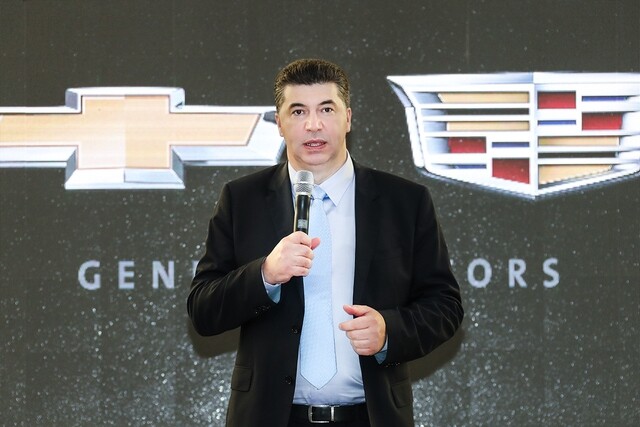hankyoreh
Links to other country sites 다른 나라 사이트 링크
GM Korea losses raise fears the US auto company will withdraw from the South Korean market

Although GM Korea celebrated the 15th anniversary of its establishment on Oct. 16, the mood was more troubled than in previous years. In addition to the 2 trillion won (US$1.76 billion) in losses that the company has racked up over the past three years, the Korea Development Bank (KDB, GM Korea’s second largest stockholder) has lost its power to block capital disposal at the company, which is prompting speculation that GM may withdraw from the Korean market.
Through September, GM Korea had sold 402,000 vehicles in the domestic and foreign markets, which is 7.5% less than the same period last year. Last month, GM Korea’s 10.7% loss made it the only domestic automaker to see its sales volume slide. As sales in the domestic market tumbled by 36.1%, the company fell to fourth in the sales rankings, behind Ssangyong Motor Company. GM Korea is looking for answers in sluggish sales of its new models and the inadequacy of its product lineup.
An even bigger problem is the non-business risk. GM Korea’s largest shareholder is General Motors (GM), the biggest automaker in the US. With a 17% share in GM Korea, the KDB had the right to veto the sale of any stake in the company – but according to its agreement with GM, that veto right expires on Oct. 17. This means that South Korea no longer has a way to stop GM from cutting ties with its subsidiary GM Korea.
The possibility of GM pulling out of the country has been raised since 2014, when the GM corporate headquarters began restructuring its global business operations. The rumors about a pullout have been gaining strength as GM Korea incurred a total of 2 trillion won in losses – including non-business losses – over the past three years.
But practically speaking, it wouldn’t be a simple matter for GM to withdraw from South Korea. GM Korea has auto plants in Changwon of South Gyeongsang Province, Bupyeong of Incheon, Gunsan of North Jeolla Province as well as a transmission factory in Boryeong of South Chungcheong Province. Considering that the company has over 10 trillion won (US$ 8.84 billion) in yearly sales and that more than 15,000 people are working at its factories, pulling out of the domestic market would no doubt be quite complicated. GM Korea has dismissed speculation about GM’s withdrawal. “We have not changed our stance that South Korea is one of the major hubs of GM’s global business operations in the areas of production, product development and design,” a company spokesperson said.
After yanking the Chevrolet brand out of Europe last year, GM has halted sales in countries such as India and South Africa and has reduced its business operations in Russia and Southeast Asia. This strategy is aimed at extricating itself from unprofitable markets – which is why the rumors about GM leaving South Korea keep swirling.
Considering GM’s global restructuring efforts, industry observers think it’s likely that the company will undertake business restructuring in South Korea, too, starting with the factories that are the most idle and that produce the least. The operating rate at the factory in Gunsan is less than 30%. Office workers are given incentives to voluntarily resign on a yearly basis. GM Korea explains that this is “aimed at increasing organizational efficiency and only applies to volunteers,” but company employees consider this a type of workforce restructuring.
By Hong Dae-sun, staff reporter
Please direct questions or comments to [english@hani.co.kr]

Editorial・opinion
![[Editorial] Does Yoon think the Korean public is wrong? [Editorial] Does Yoon think the Korean public is wrong?](https://flexible.img.hani.co.kr/flexible/normal/500/300/imgdb/original/2024/0417/8517133419684774.jpg) [Editorial] Does Yoon think the Korean public is wrong?
[Editorial] Does Yoon think the Korean public is wrong?![[Editorial] As it bolsters its alliance with US, Japan must be accountable for past [Editorial] As it bolsters its alliance with US, Japan must be accountable for past](https://flexible.img.hani.co.kr/flexible/normal/500/300/imgdb/original/2024/0417/6817133413968321.jpg) [Editorial] As it bolsters its alliance with US, Japan must be accountable for past
[Editorial] As it bolsters its alliance with US, Japan must be accountable for past- [Guest essay] Amending the Constitution is Yoon’s key to leaving office in public’s good graces
- [Editorial] 10 years on, lessons of Sewol tragedy must never be forgotten
- [Column] A death blow to Korea’s prosecutor politics
- [Correspondent’s column] The US and the end of Japanese pacifism
- [Guest essay] How Korea turned its trainee doctors into monsters
- [Guest essay] As someone who helped forge Seoul-Moscow ties, their status today troubles me
- [Editorial] Koreans sent a loud and clear message to Yoon
- [Column] In Korea’s midterm elections, it’s time for accountability
Most viewed articles
- 1[Column] The clock is ticking for Korea’s first lady
- 2Samsung barricades office as unionized workers strike for better conditions
- 3[Editorial] When the choice is kids or career, Korea will never overcome birth rate woes
- 4S. Korea, Japan reaffirm commitment to strengthening trilateral ties with US
- 5[News analysis] After elections, prosecutorial reform will likely make legislative agenda
- 6Japan officially says compensation of Korean forced laborers isn’t its responsibility
- 7[Editorial] As it bolsters its alliance with US, Japan must be accountable for past
- 8[Editorial] Does Yoon think the Korean public is wrong?
- 9Why Israel isn’t hitting Iran with immediate retaliation
- 10[Interview] Learning about the Sewol tragedy through BTS